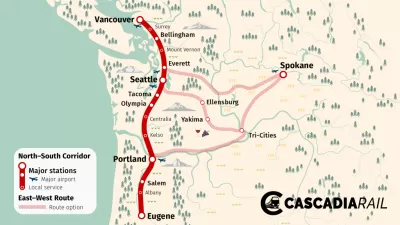The New York Times recently checked in with the California High-Speed Rail project and reported the current details, still in the process of a long evolution.

Jill Cowan writes for the New York Times to describe the California High-Speed Rail project at a "crossroads": 1,000 workers are currently employed in the state's Central Valley building along 119 miles or right away, but the project is inching along compared to its high-speed ambitions. State voters approved a $10 bond in 2008 and the project broke ground in 2015, and planning for the project goes much further back into history. The California High-Speed Rail Authority was established in 1996, for instance.
The premise of Cowan's article, given how much time has elapsed and the relatively inconspicuous signs of the project's development along Highway 99: "many California residents have long since lost track of what is being built where, and when or if it will ever be completed."
"In 2008, when the bond measure passed, the project symbolized the state’s ambition to build and think big," writes Cowan. "But in the years since then, the project has become something else: an alarming vision of a nation that seems incapable of completing the transformative projects necessary to confront 21st century challenges."
As noted in the article, the Biden administration is pushing the approval of the federal Infrastructure Investment and Jobs Act as signs of a coming "infrastructure decade." The California High-Speed Rail promises nothing more, at this point in the history detailed in the source article below, than to be one of the toughest tests of that ambition.
FULL STORY: California’s Ambitious High-Speed Rail at a Crossroads

Alabama: Trump Terminates Settlements for Black Communities Harmed By Raw Sewage
Trump deemed the landmark civil rights agreement “illegal DEI and environmental justice policy.”

Study: Maui’s Plan to Convert Vacation Rentals to Long-Term Housing Could Cause Nearly $1 Billion Economic Loss
The plan would reduce visitor accommodation by 25% resulting in 1,900 jobs lost.

Why Should We Subsidize Public Transportation?
Many public transit agencies face financial stress due to rising costs, declining fare revenue, and declining subsidies. Transit advocates must provide a strong business case for increasing public transit funding.

Paris Bike Boom Leads to Steep Drop in Air Pollution
The French city’s air quality has improved dramatically in the past 20 years, coinciding with a growth in cycling.

Why Housing Costs More to Build in California Than in Texas
Hard costs like labor and materials combined with ‘soft’ costs such as permitting make building in the San Francisco Bay Area almost three times as costly as in Texas cities.

San Diego County Sees a Rise in Urban Coyotes
San Diego County experiences a rise in urban coyotes, as sightings become prevalent throughout its urban neighbourhoods and surrounding areas.
Urban Design for Planners 1: Software Tools
This six-course series explores essential urban design concepts using open source software and equips planners with the tools they need to participate fully in the urban design process.
Planning for Universal Design
Learn the tools for implementing Universal Design in planning regulations.
Smith Gee Studio
Alamo Area Metropolitan Planning Organization
City of Santa Clarita
Institute for Housing and Urban Development Studies (IHS)
City of Grandview
Harvard GSD Executive Education
Toledo-Lucas County Plan Commissions
Salt Lake City
NYU Wagner Graduate School of Public Service





























